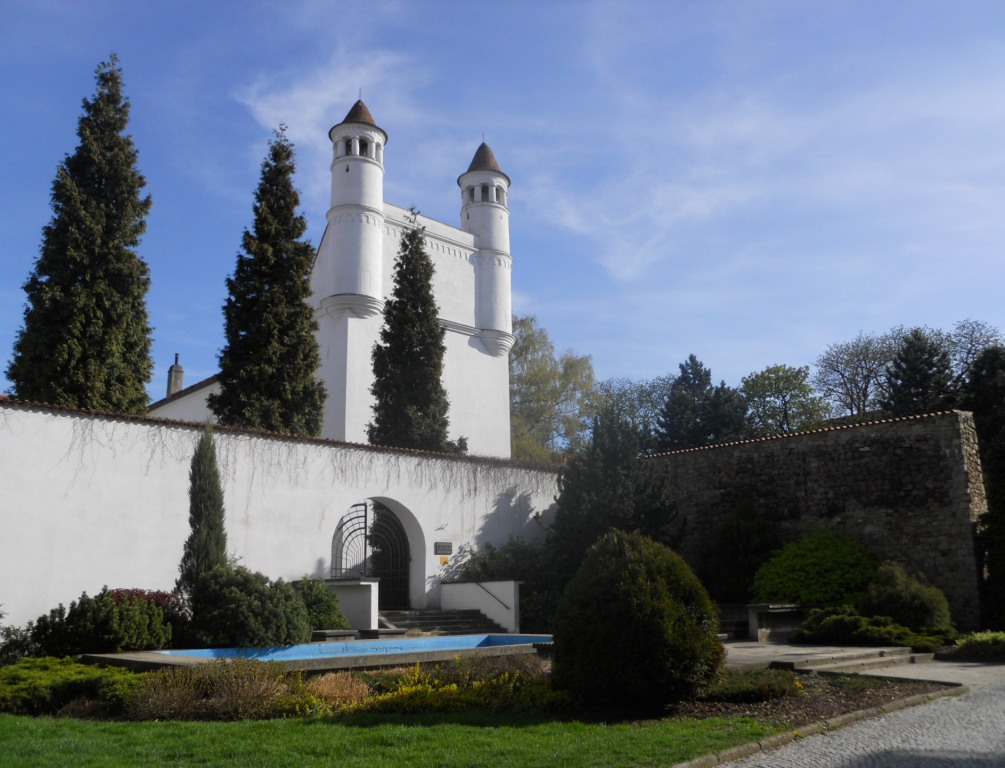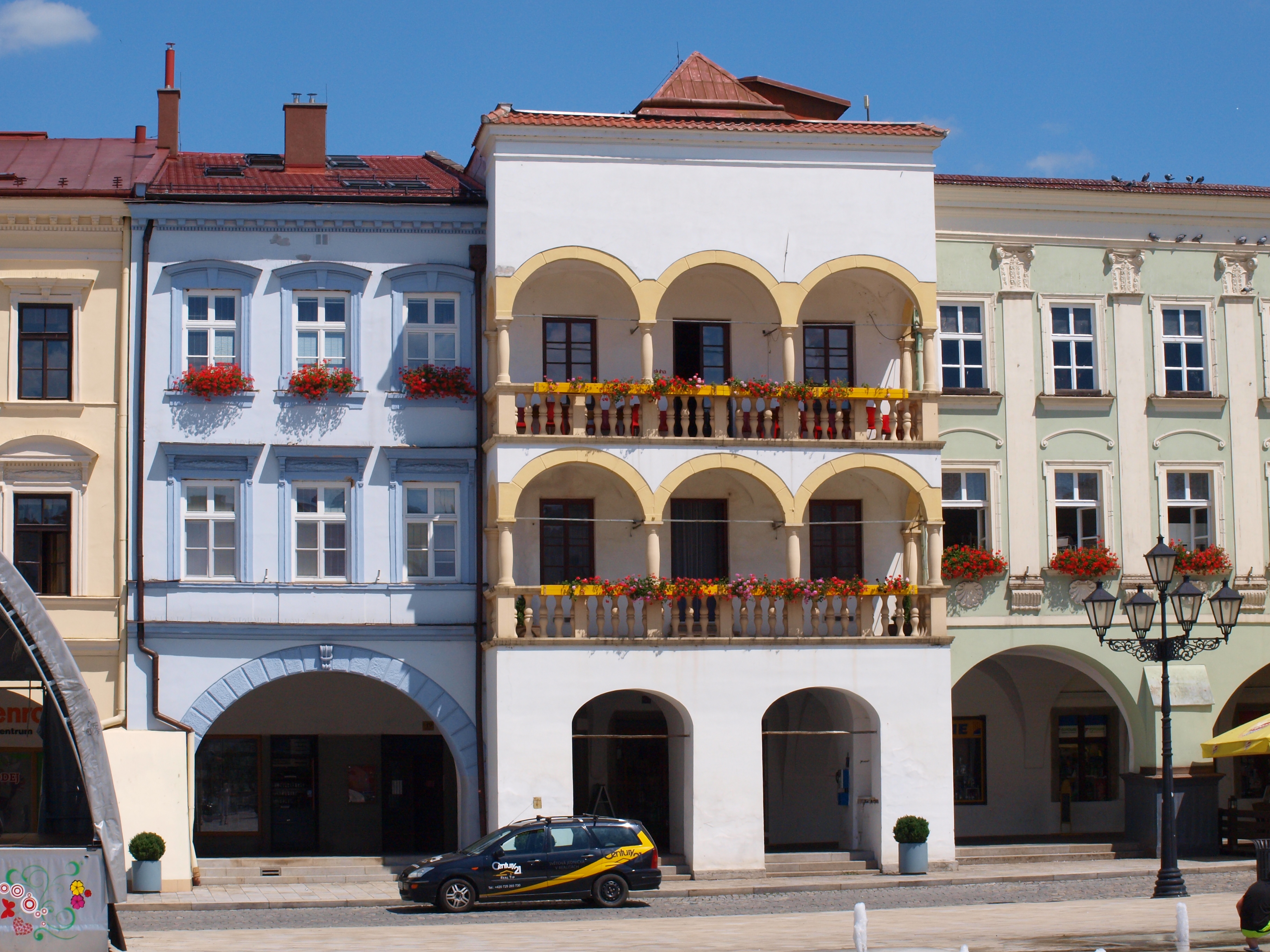Nový Jičín on:
[Wikipedia]
[Google]
[Amazon]
Nový Jičín (; german: Neutitschein) is a town in the

 The first written mention of Nový Jičín is from 1313, however it was probably founded in around 1280. It was established as the economic centre of the
The first written mention of Nový Jičín is from 1313, however it was probably founded in around 1280. It was established as the economic centre of the
 The historic core of Nový Jičín is a Renaissance-Baroque town with a pure example of medieval urbanism of the second half of the 13th century. In its centre is a square with arcades and a rectangular system of adjacent streets. In the 16th century, the arcades were built and the wooden houses were replaced by stone ones.
The town square is lined by preserved Renaissance and Baroque burger houses. The town hall was a Renaissance house from the 16th century, rebuilt to the town hall in 1661. In 1881, the façade was rebuilt and modified in the pseudo-Gothic style. In 1929–1930, an insensitive pseudo-Renaissance reconstruction was made.
The most valuable house is ''Stará pošta'' (i.e. "old post office"), a two-storey Renaissance house from 1563. In a historic house where general
The historic core of Nový Jičín is a Renaissance-Baroque town with a pure example of medieval urbanism of the second half of the 13th century. In its centre is a square with arcades and a rectangular system of adjacent streets. In the 16th century, the arcades were built and the wooden houses were replaced by stone ones.
The town square is lined by preserved Renaissance and Baroque burger houses. The town hall was a Renaissance house from the 16th century, rebuilt to the town hall in 1661. In 1881, the façade was rebuilt and modified in the pseudo-Gothic style. In 1929–1930, an insensitive pseudo-Renaissance reconstruction was made.
The most valuable house is ''Stará pošta'' (i.e. "old post office"), a two-storey Renaissance house from 1563. In a historic house where general
Sightseeing in the town
{{DEFAULTSORT:Novy Jicin Populated places in Nový Jičín District Cities and towns in the Czech Republic Margraviate of Moravia
Moravian-Silesian Region
The Moravian-Silesian Region ( cs, Moravskoslezský kraj; pl, Kraj morawsko-śląski; sk, Moravsko-sliezsky kraj) is one of the 14 administrative regions of the Czech Republic. Before May 2001, it was called the Ostrava Region ( cs, Ostravský ...
of the Czech Republic
The Czech Republic, or simply Czechia, is a landlocked country in Central Europe. Historically known as Bohemia, it is bordered by Austria to the south, Germany to the west, Poland to the northeast, and Slovakia to the southeast. The Cz ...
. It has about 23,000 inhabitants. The historic centre of Nový Jičín is well preserved and is protected by law as an urban monument reservation.
Nový Jičín is known for the hatting industry and is nicknamed the "town of hats".
Administrative parts
Villages of Bludovice, Kojetín, Loučka, Straník and Žilina are administrative parts of Nový Jičín.Etymology
There are two theories as to how the name "Jičín" came about. According to local legends, it could be derived from the brave daughter of a local castle owner named Jitka (''Jitčín'', later amended to Jičín). Another theory derives the name from the Slavic word forwild boar
The wild boar (''Sus scrofa''), also known as the wild swine, common wild pig, Eurasian wild pig, or simply wild pig, is a Suidae, suid native to much of Eurasia and North Africa, and has been introduced to the Americas and Oceania. The speci ...
''div'' (''Dičín'', later amended to Jičín).
The attribute ''Nový'' ("new") was added to distinguish it from Starý Jičín
Starý Jičín (german: Alttitschein, Alt Titschein) is a municipality and village in Nový Jičín District in the Moravian-Silesian Region of the Czech Republic
The Czech Republic, or simply Czechia, is a landlocked country in Centr ...
("Old Jičín").
Geography
Nový Jičín is situated about southwest ofOstrava
Ostrava (; pl, Ostrawa; german: Ostrau ) is a city in the north-east of the Czech Republic, and the capital of the Moravian-Silesian Region. It has about 280,000 inhabitants. It lies from the border with Poland, at the confluences of four rive ...
. It is located in the Moravian-Silesian Foothills. The town lies on the small river of Jičínka, at its confluence with streams Zrzávka, Grasmanka and Rakovec.
History
Starý Jičín
Starý Jičín (german: Alttitschein, Alt Titschein) is a municipality and village in Nový Jičín District in the Moravian-Silesian Region of the Czech Republic
The Czech Republic, or simply Czechia, is a landlocked country in Centr ...
estate. It was a property of Lords of Kravaře and later of the Zierotin family.
Žerotínský Castle was originally part of the town fortifications, the construction of which began in the 1380s and continued in the early 16th century. During the rule of Bedřich of Zierotin (1533–1541), the castle was rebuilt into a Renaissance residence.
In 1620 Frederick V promoted Nový Jičín to a royal town. The town was decimated by Thirty Years' War
The Thirty Years' War was one of the longest and most destructive conflicts in European history, lasting from 1618 to 1648. Fought primarily in Central Europe, an estimated 4.5 to 8 million soldiers and civilians died as a result of batt ...
and by large fires in 1768 and 1773.
In the 19th century the Jewish population returned to the town and large textile factories were established. The hatter industry has flourished and Nový Jičín is still today called the "town of hats". During the industrialization in the mid-19th century, two town gates and most turrets and attic of the castle were demolished. Only two defense towers were left in memory.
Until 1918 the town was part of the Austrian monarchy
The Habsburg monarchy (german: Habsburgermonarchie, ), also known as the Danubian monarchy (german: Donaumonarchie, ), or Habsburg Empire (german: Habsburgerreich, ), was the collection of empires, kingdoms, duchies, counties and other polities ...
(Austria side after the compromise of 1867
The Austro-Hungarian Compromise of 1867 (german: Ausgleich, hu, Kiegyezés) established the dual monarchy of Austria-Hungary. The Compromise only partially re-established the former pre-1848 sovereignty and status of the Kingdom of Hungary ...
), head of the district with the same name, one of the 34 ''Bezirkshauptmannschaften'' in Moravia
Moravia ( , also , ; cs, Morava ; german: link=yes, Mähren ; pl, Morawy ; szl, Morawa; la, Moravia) is a historical region in the east of the Czech Republic and one of three historical Czech lands, with Bohemia and Czech Silesia.
The me ...
. The German population was expelled in 1945.
Demographics
Economy
Nový Jičín is known for the hatting industry. Hats have been made here since 1630. The mechanical production began here in 1865 and is the oldest hat factory in the world. The modern TONAK company was established in 1945 and is still one of the three largest headwear manufacturers in the world. The largest employer with headquarters in the town is Hanon Systems Autopal, a manufacturer of refrigeration and air conditioning components for the automotive industry.Transport
Nový Jičín lies on the European route E462. The town lies about from the station on the high-speed railway line inSuchdol nad Odrou
Suchdol nad Odrou (german: Zauchtenthal, Zauchtel) is a market town in Nový Jičín District in the Moravian-Silesian Region of the Czech Republic. It has about 2,700 inhabitants.
Administrative parts
The village of Kletné is an administrative ...
. There is the Nový Jičín–Suchdol nad Odrou
Suchdol nad Odrou (german: Zauchtenthal, Zauchtel) is a market town in Nový Jičín District in the Moravian-Silesian Region of the Czech Republic. It has about 2,700 inhabitants.
Administrative parts
The village of Kletné is an administrative ...
railway line of local importance.
The largest airport in the region, Leoš Janáček Airport Ostrava is about 15 kilometres from Nový Jičín.
Sights
Ernst Gideon von Laudon
Ernst Gideon von Laudon, since 1759 Freiherr von Laudon (originally Laudohn or Loudon; 13 February 171714 July 1790), was a Baltic German-born Austrian generalisimo and one of the most successful opponents of the Prussian king Frederick the Grea ...
died in 1790 is the tourist information centre and an exposition of the hat-making tradition of Nový Jičín.
The Church of the Assumption of the Virgin Mary is the landmark of the historic centre. It has a Renaissance high tower from 1587. The original Gothic castle was replaced by the current building by the Jesuits
, image = Ihs-logo.svg
, image_size = 175px
, caption = ChristogramOfficial seal of the Jesuits
, abbreviation = SJ
, nickname = Jesuits
, formation =
, founders = ...
in 1732–1740.
The oldest stone building in Nový Jičín is the Žerotínský Castle from the 1380s. Today it houses the regional museum. Only a bastion from 1613 and few fragments of the town walls are preserved to this day.
Notable people
*Ernst Gideon von Laudon
Ernst Gideon von Laudon, since 1759 Freiherr von Laudon (originally Laudohn or Loudon; 13 February 171714 July 1790), was a Baltic German-born Austrian generalisimo and one of the most successful opponents of the Prussian king Frederick the Grea ...
(1717–1790), German-Austrian generalisimo; died here
* Eduard Veith (1858–1925), Austrian painter
* Adolf Herz (1862–1947), Austrian-Swiss engineer and inventor
* Hugo Baar (1873–1912), Moravian-German landscape painter
* Božena Benešová (1873–1936), writer
*Alfred Neubauer
Alfred Neubauer (29 March 1891 in Neutitschein – 22 August 1980 in Stuttgart) was the racing manager of the Mercedes-Benz Grand Prix team from 1926 to 1955.
Biography
Neubauer's father, Karl Neubauer, was a furniture-maker in Neutitschein () ...
(1891–1980), racing manager
* Fred Liewehr (1909–1993), Austrian actor
* Max Mannheimer (1920–2016), writer, survivor of the Holocaust
* Vladimír Válek (born 1935), conductor
* Harun Farocki (1944–2014), German filmmaker and author
* František Černík (born 1953), ice hockey player
* Stanislav Moša (born 1956), theatre and musical director
* Karel Stromšík (born 1958), footballer
* Vlasta Redl (born 1959), folk musician
* Kateřina Konečná (born 1981), politician
* Rostislav Klesla (born 1982), ice hockey player
* Tomáš Sklenák (born 1982), handball player
* Lenka Masná (born 1985), athlete
* Karolína Huvarová (born 1986), fitness trainer and model
* Petra Klosová (born 1986), swimmer
Twin towns – sister cities
Nový Jičín is twinned with: *Épinal
Épinal (; german: Spinal) is a commune in northeastern France and the prefecture of the Vosges department.
Geography
The commune has a land area of . It is situated on the river Moselle, south of Nancy. Épinal station has rail connecti ...
, France
* Görlitz
Görlitz (; pl, Zgorzelec, hsb, Zhorjelc, cz, Zhořelec, East Lusatian dialect: ''Gerlz'', ''Gerltz'', ''Gerltsch'') is a town in the German state of Saxony. It is located on the Lusatian Neisse River, and is the largest town in Upper Lu ...
, Germany
* Kremnica
Kremnica (; german: Kremnitz, hu, Körmöcbánya) is a town in central Slovakia. It has around 5,300 inhabitants. The well-preserved medieval town built above important gold mines is the site of the oldest still-working mint in the world.
Nam ...
, Slovakia
* Ludwigsburg
Ludwigsburg (; Swabian: ''Ludisburg'') is a city in Baden-Württemberg, Germany, about north of Stuttgart city centre, near the river Neckar. It is the largest and primary city of the Ludwigsburg district with about 88,000 inhabitants. It is ...
, Germany
* Novellara, Italy
* Świętochłowice, Poland
References
External links
*Sightseeing in the town
{{DEFAULTSORT:Novy Jicin Populated places in Nový Jičín District Cities and towns in the Czech Republic Margraviate of Moravia